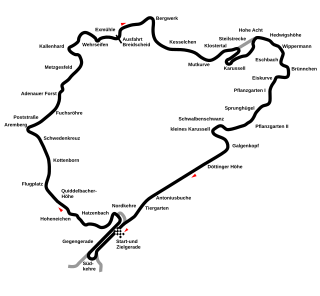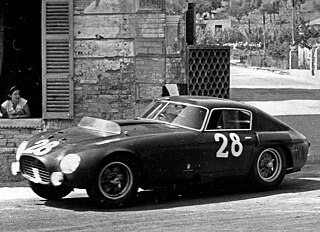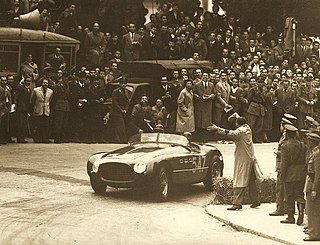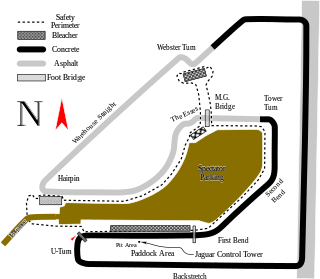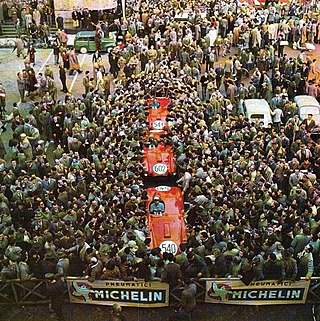| Pos | Class | No. | Entrant | Driver(s) | Car | Stages | Time |
|---|
| 1 | S+1.6 | 36 | Scuderia Lancia |  Juan Manuel Fangio Juan Manuel Fangio
 Gino Bronzoni Gino Bronzoni | Lancia D24 Pinin Farina | 8 | 18:11:00 |
|---|
| 2 | S+1.6 | 22 | Scuderia Lancia |  Piero Taruffi Piero Taruffi
 Luigi Maggio Luigi Maggio | Lancia D24 Pinin Farina | 8 | 18:18:51 |
|---|
| 3 | S+1.6 | 38 | Scuderia Lancia |  Eugenio Castellotti Eugenio Castellotti
 Carlo Luoni Carlo Luoni | Lancia D23 Pinin Farina | 8 | 18:24:52 |
|---|
| 4 | S+1.6 | 26 | Scuderia Guastalla |  Guido Mancini Guido Mancini
 Fabrizio Serena di Lapigio Fabrizio Serena di Lapigio | Ferrari 375 MM Pinin Farina Berlinetta | 8 | 19:40:29 |
|---|
| 5 | S+1.6 | 6 | Club Francia Amigos de la Panamericana |  Louis Rosier Louis Rosier | Talbot-Lago T26GS | 8 | 20:11:22 |
|---|
| 6 | S+1.6 | 23 | Scuderia Guastalla |  Mario Ricci Mario Ricci
 Forese Salviati Forese Salviati | Ferrari 375 MM Pinin Farina Berlinetta | 8 | 20:16:28 |
|---|
| 7 | T | 52 | Bob Estes |  Chuck Stevenson Chuck Stevenson
 Clay Smith Clay Smith | Lincoln Capri | 8 | 20:31:32 |
|---|
| 8 | T | 53 | Bob Estes |  Walt Faulkner Walt Faulkner
 Chuck Daigh Chuck Daigh | Lincoln Capri | 8 | 20:32:55 |
|---|
| 9 | T | 95 | Ronald Ferguson |  Jack McGrath Jack McGrath
 Manuel Ayulo Manuel Ayulo | Lincoln Capri | 8 | 20:33:07 |
|---|
| 10 | T | 51 | Bob Estes |  Johnny Mantz Johnny Mantz
 Bill Stroppe Bill Stroppe | Lincoln Capri | 8 | 20:33:30 |
|---|
| 11 | S+1.6 | 5 | Efraín Ruiz Echeverría |  Efraín Ruiz Echeverría Efraín Ruiz Echeverría
 Pedro Villegas Becerril Pedro Villegas Becerril | Ferrari 250 MM Pinin Farina | 8 | 20:48:29 |
|---|
| 12 | T | 66 | A. B. Poe |  Tommy Drisdale Tommy Drisdale
 Johnny Gomez Johnny Gomez | Chrysler New Yorker | 8 | 21:21:19 |
|---|
| 13 | T | 67 | Knox Converse |  Royal Russell Royal Russell
 Jesse Ashley Jesse Ashley | Chrysler New Yorker | 8 | 21:34:26 |
|---|
| 14 | S+1.6 | 11 | Akton Miller |  Ak Miller Ak Miller
 Douglas Harrison Douglas Harrison | Caballo de Hiero-Oldsmobile | 8 | 22:07:36 |
|---|
| 15 | T | 60 | Oscar Alfredo Gálvez |  Oscar Alfredo Gálvez Oscar Alfredo Gálvez
 Eduardo Martínez Eduardo Martínez | Lincoln Capri | 8 | 22:18:44 |
|---|
| 16 | T | 79 | Jorge Descote |  Jorge Descote Jorge Descote | Lincoln Capri | 8 | 22:27:01 |
|---|
| 17 | T | 64 | E. N. de Milo |  Ernesto Petrini Ernesto Petrini
 Alberto Fiorentini Alberto Fiorentini | Lincoln Capri | 8 | 22:28:36 |
|---|
| 18 | T | 59 | Douglas Ehlinger |  Douglas Ehlinger Douglas Ehlinger
 Luis Solorio Luis Solorio | Packard Mayfair | 8 | 22:34:40 |
|---|
| 19 | T | 72 | Thomas A. Deal |  Bill Sterling Bill Sterling
 Julius L. Colspret Julius L. Colspret | Cadillac Series 62 | 8 | 22:40:30 |
|---|
| 20 | T | 93 | Pat Zoccano |  Pat Zoccano Pat Zoccano
 Glen N. Barnhart Glen N. Barnhart | Buick | 8 | 22:42:21 |
|---|
| 21 | T | 55 | Union de Choferes |  Roberto Belmar Roberto Belmar
 Angel Acar Valle Angel Acar Valle | DeSoto Diplomat | 8 | 22:45:02 |
|---|
| 22 | T | 101 | Arturo Alvarez Tostado |  Arturo Alvarez Tostado Arturo Alvarez Tostado
 Alfredo Cabrero Porras Alfredo Cabrero Porras | Chrysler New Yorker | 8 | 22:50:59 |
|---|
| 23 | T | 118 | James Rice |  Ferdinando de Leeuw Murphy Ferdinando de Leeuw Murphy
 Cornelio Medina Cornelio Medina | Lincoln Capri | 8 | 22:51:28 |
|---|
| 24 | T | 113 | Ricardo Ramirez |  Ricardo Ramírez Ricardo Ramírez | Oldsmobile 88 | 8 | 23:01:10 |
|---|
| 25 | S+1.6 | 25 | Guillermo Girón |  Guillermo Girón Guillermo Girón
 Rodolfo Beaudin Rodolfo Beaudin | Jaguar XK120 | 8 | 23:01:49 |
|---|
| 26 | T | 102 | Juan de Aguinaco |  Juan de Aguinaco Juan de Aguinaco | Oldsmobile 88 | 8 | 23:02:47 |
|---|
| 27 | T | 70 | Al Rogers |  Al Rogers Al Rogers
 Ralph Rogers Ralph Rogers | Chrysler New Yorker | 8 | 23:13:45 |
|---|
| 28 | T | 88 | Ernest C. Hall |  Ernest C. Hall Ernest C. Hall
 Louis Unser Louis Unser | Buick | 8 | 23:14:35 |
|---|
| 29 | T | 87 | Luis Rafael Garzon |  Luis Rafael Garzon Luis Rafael Garzon
 William Griebling William Griebling | Oldsmobile 88 | 8 | 23:28:15 |
|---|
| 30 | T | 114 | Hector Rivapalacio |  Hector Riva Palacio Hector Riva Palacio
 Juan Courtney Juan Courtney | Oldsmobile 88 | 8 | 23:28:20 |
|---|
| 31 | T | 82 | Gilberto Julian Riega |  Gilberto Julian Riega Gilberto Julian Riega
 Modesto Jose Riega Modesto Jose Riega | Lincoln Capri | 8 | 23:55:50 |
|---|
| 32 | S1.6 | 152 | José Herrarte Ariano |  José Sala Herrarte Ariano José Sala Herrarte Ariano
 Carlos A. González Carlos A. González | Porsche 550 Coupé | 8 | 23:57:04 |
|---|
| 33 | S1.6 | 158 | |  Fernando Segura Fernando Segura | Porsche 356 Super | 8 | 24:18:25 |
|---|
| 34 | TS | 217 | C. D. Evans |  C. D. Evans C. D. Evans
 Walter Krause, Jr. Walter Krause, Jr. | Chevrolet 210 | 8 | 24:48:21 |
|---|
| 35 | TS | 207 | Norman Patterson |  Norman Patterson Norman Patterson
 Bernie Shires Bernie Shires | Ford V8 | 8 | 24:58:55 |
|---|
| 36 | TS | 209 | Oscar Cabalen |  Oscar Cabalén Oscar Cabalén
 Guillermo Ibanda Guillermo Ibanda | Ford 6 | 8 | 25:03:48 |
|---|
| 37 | TS | 259 | Scott F. Yantis |  Scott F. Yantis Scott F. Yantis | Chevrolet 210 | 8 | 25:09:51 |
|---|
| 38 | TS | 235 | Malcolm Eckart |  Malcolm Eckart Malcolm Eckart
 Carroll Hamplemann Carroll Hamplemann | Hudson Jet | 8 | 25:17:05 |
|---|
| 39 | TS | 238 | Humberto Maneglia |  Humberto Maneglia Humberto Maneglia | Ford 6 | 8 | 25:34:27 |
|---|
| 40 | TS | 222 | Hector Ortiz Palacios |  Hector Ortiz Palacios Hector Ortiz Palacios
 Ramon Leal Contreras Ramon Leal Contreras | Plymouth Belvedere | 8 | 25:53:31 |
|---|
| 41 | TS | 204 | Segurs Chapultepec |  Francisco Ramirez Fonseca Francisco Ramirez Fonseca
 Alberto Maya Juarez Alberto Maya Juarez | Hudson Jet | 8 | 25:59:48 |
|---|
| 42 | TS | 225 | Enrique Paredes |  Enrique Paredes Enrique Paredes
 Luis Herrastri Luis Herrastri | Hudson Jet | 8 | 26:00:42 |
|---|
| 43 | TS | 245 | Tadeo Taddia |  Tadeo Taddia Tadeo Taddia
 Sebastian Florencio Sebastian Florencio | Chevrolet 210 | 8 | 26:01:53 |
|---|
| 44 | TS | 268 | Miguel Vinardell |  Miguel Vinardell Miguel Vinardell | Chevrolet Bel Air | 8 | 26:03:33 |
|---|
| 45 | TS | 256 | Baltazar Alaimo |  Baltazar Alaimo Baltazar Alaimo
 Eliseo Rodriguez Eliseo Rodriguez | Chevrolet 210 | 8 | 26:04:08 |
|---|
| 46 | T | 147 | Clemente Aspe |  Clemente Aspe Clemente Aspe | Mercury Monterey | 8 | 26:05:44 |
|---|
| 47 | TS | 282 | Rafael Larocca |  Rafael Larocca Rafael Larocca | Ford 6 | 8 | 26:06:05 |
|---|
| 48 | TS | 210 | Morelos |  Carlos Diaz Garcilazo Carlos Diaz Garcilazo
 Enrique Alvarado Enrique Alvarado | Studebaker Champion | 8 | 26:10:36 |
|---|
| 49 | TS | 228 | Luis Maria Martorani |  Luis Maria Martorani Luis Maria Martorani | Ford Victoria | 8 | 26:11:56 |
|---|
| 50 | TS | 244 | Guillermo G. Airaldi |  Guillermo G. Airaldi Guillermo G. Airaldi
 Francisco Spatafora Francisco Spatafora | Chevrolet 210 | 8 | 26:25:21 |
|---|
| 51 | TS | 258 | Domingo B. Lombardi |  Domingo B. Lombardi Domingo B. Lombardi
 Jorge Jose Ferrario Jorge Jose Ferrario | Ford 6 | 8 | 26:27:41 |
|---|
| 52 | TS | 277 | Robert E. Barckimer |  Robert E. Barckimer Robert E. Barckimer
 Frank Danley Frank Danley | Ford 6 | 8 | 26:40:39 |
|---|
| 53 | TS | 215 | Leones Doroles Club, Hidalgo |  Rafael González Sandoval Rafael González Sandoval
 Aurelio Lara Aurelio Lara | Nash Statesman | 8 | 26:54:23 |
|---|
| 54 | TS | 272 | Carlos Fortunati Firpo |  Carlos Fortunati Firpo Carlos Fortunati Firpo | Ford 6 | 8 | 27:00:50 |
|---|
| 55 | TS | 276 | Oscar Martorani |  Oscar Martorani Oscar Martorani | Ford 6 | 8 | 27:01:13 |
|---|
| 56 | TS | 248 | Carlos Pfeffer |  Carlos Pfeffer Carlos Pfeffer
 Antonio Luís Michelini Antonio Luís Michelini | Ford 6 | 8 | 28:07:55 |
|---|
| 57 | TS | 278 | Carlos Battilana Olazabal |  Carlos Battilana Olazabal Carlos Battilana Olazabal | Ford 6 | 8 | 28:14:19 |
|---|
| 58 | TS | 255 | Guillermo Marenghini |  Guillermo Marenghini Guillermo Marenghini
 Alfred Rho Alfred Rho | Chevrolet | 8 | 28:24:41 |
|---|
| 59 | TS | 227 | Sebastian Gonzalez |  Sebastián González Sebastián González
 Carlos Soto Olivares Carlos Soto Olivares | Ford Victoria | 8 | 28:27:21 |
|---|
| 60 | TS | 257 | Omar Nestor Bide White |  Omar Nestor Bide White Omar Nestor Bide White | Chevrolet 210 | 8 | 30:53:14 |
|---|
61
NC | S1.6 | 155 | Hans Hugo Hartmann |  Hans Hugo Hartmann Hans Hugo Hartmann | Borgward Hansa 1500 RS | 8 | Over time limit |
|---|
62
DNF | S1.6 | 154 | Jaroslav Juhan |  Jaroslav Juhan Jaroslav Juhan
 Antonio Asturias Hall Antonio Asturias Hall | Porsche 550 Coupé | 7 | Mechanical |
|---|
63
DNF | S1.6 | 162 | Manfredo Lippmann |  Manfredo Lippmann Manfredo Lippmann | Porsche 356 Super | 7 | Mechanical |
|---|
64
DNF | TS | 218 | Remo Gamalero |  Remo Gamalero Remo Gamalero
 Juan Carlos Domínguez Juan Carlos Domínguez | Ford 6 | 7 | Mechanical |
|---|
65
DNF | TS | 269 | Mario Reibaldi |  Mario Reibaldi Mario Reibaldi | Ford 6 | 7 | Over time limit |
|---|
66
DNF | TS | 271 | Jorge Daponte |  Jorge Daponte Jorge Daponte | Chevrolet 210 | 7 | Mechanical |
|---|
67
DNF | T | 63 | Liga Nacional del Transporte |  Luis Leal Solares Luis Leal Solares
 Alfredo Garcia Avila Alfredo Garcia Avila | Lincoln Capri | 6 | Over time limit |
|---|
68
DNF | TS | 233 | Andres Ferreno Barreiro |  Andres Ferreno Barreiro Andres Ferreno Barreiro
 Juan Carlos Suárez Juan Carlos Suárez | Ford 6 | 6 | DNF |
|---|
69
DNF | TS | 262 | Agustin Aguaviva |  Agustin Aguaviva Agustin Aguaviva | Ford 6 | 6 | DNF |
|---|
70
DNF | S+1.6 | 9 | O'Farrill |  Jean Trévoux Jean Trévoux
 Jean Bachereaux Jean Bachereaux | Packard Motto Special | 5 | DNF |
|---|
71
DNF | T | 57 | E. Carl Kiekhaefer |  Frank Menendez Frank Menendez
 James E. Beake James E. Beake | Chrysler New Yorker | 5 | Over time limit |
|---|
72
DNF | S1.6 | 151 | Calzado Canada |  Salvador López Chávez Salvador López Chávez | Porsche 356 | 5 | Engine |
|---|
73
DNF | TS | 212 | Douglas Marimon |  Douglas Marimon Douglas Marimon | Ford 6 | 5 | DNF |
|---|
74
DNF | TS | 240 | Vincente Tirabasso |  Vincente Tirabasso Vincente Tirabasso | Chevrolet | 5 | DNF |
|---|
75
DNF | TS | 254 | Angel Lovalvo |  Angel Lovalvo Angel Lovalvo
 Antonio Spampinato Antonio Spampinato | Ford Victoria | 5 | DNF |
|---|
76
DNF | S+1.6 | 7 | Club Francia Amigos de la Panamericana |  Jean Behra Jean Behra | Gordini T24S | 4 | Accident |
|---|
77
DNF | S+1.6 | 8 | Club Francia Amigos de la Panamericana |  Jean Lucas Jean Lucas | Gordini T16S | 4 | Over time limit |
|---|
78
DNF | S+1.6 | 12 | Scuderia Guastalla |  Umberto Maglioli Umberto Maglioli
 Piero Cassani Piero Cassani | Ferrari 375 MM Pinin Farina Berlinetta | 4 | Lost wheel, accident |
|---|
79
DNF | S1.6 | 153 | Guillermo Suhr |  Guillermo Suhr Contreras Guillermo Suhr Contreras
 Oscar Alfonso Oscar Alfonso | Porsche 356 | 4 | Over time limit (Accident) |
|---|
80
DNF | TS | 280 | Jose Brea |  Jose Brea Jose Brea
 Alfonso Moreno Alfonso Moreno | Ford 6 | 4 | DNF |
|---|
81
DNF | S+1.6 | 34 | Scuderia Lancia |  Felice Bonetto Felice Bonetto | Lancia D24 Pinin Farina | 3 | Fatal accident |
|---|
82
DNF | S+1.6 | 50 | Scuderia Lancia |  Giovanni Bracco Giovanni Bracco | Lancia D23 Pinin Farina | 3 | Accident |
|---|
83
DNF | T | 61 | Philips Radio Mexico |  Felix Cerda Loza Felix Cerda Loza
 José Aguilar José Aguilar | Lincoln Capri | 3 | Engine |
|---|
84
DNF | T | 80 | Hayes/McNamamra |  Keith Andrews Keith Andrews
 Pete Woods, Jr. Pete Woods, Jr. | Cadillac Series 62 | 3 | DNF |
|---|
85
DNF | T | 149 | Ray Crawford |  Ray Crawford Ray Crawford | Lincoln Capri | 3 | Engine |
|---|
86
DNF | TS | 221 | Manuel Hidalgo |  Manuel Hidalgo Manuel Hidalgo
 Luis Bicio Luis Bicio | Ford 6 | 3 | DNF |
|---|
87
DNF | TS | 223 | Jose Rubiol Roca |  Jose Rubiol Roca Jose Rubiol Roca | Ford 6 | 3 | Engine |
|---|
88
DNF | TS | 239 | Daniel Musso |  Daniel Musso Daniel Musso | Ford 6 | 3 | DNF |
|---|
89
DNF | TS | 241 | Manuel Cobas |  Manuel Cobas Manuel Cobas | Ford 6 | 3 | DNF |
|---|
90
DNF | TS | 247 | Ricardo Julian Manrique |  Ricardo Julian Manrique Ricardo Julian Manrique | Chevrolet | 3 | DNF |
|---|
91
DNF | TS | 252 | Fernando Tirabasso |  Fernando Tirabasso Fernando Tirabasso
 Antonio Vidal Antonio Vidal | Ford Victoria | 3 | DNF |
|---|
92
DNF | TS | 253 | Hugo Servetto |  Hugo Servetto Hugo Servetto
 Francisco Vega Monroy Francisco Vega Monroy | Ford Victoria | 3 | DNF |
|---|
93
DNF | TS | 286 | Ruben J. Joly |  Ruben J. Joly Ruben J. Joly | Chevrolet | 3 | DNF |
|---|
94
DNF | TS | 288 | Eugenio Veicier |  Eugenio Veicier Eugenio Veicier
 Alfonso Hernandez Alfonso Hernandez | Chevrolet 210 | 3 | Accident |
|---|
95
DNF | TS | 300 | Anza Hermanos |  Rogelio Anza Rogelio Anza
 Ricardo Pola Ricardo Pola | Ford 6 | 3 | Accident |
|---|
96
DNF | S+1.6 | 4 | Allen Guiberson |  Phil Hill Phil Hill
 Richie Ginther Richie Ginther | Ferrari 340 Mexico Vignale Coupé | 2 | Accident |
|---|
97
DNF | S+1.6 | 21 | Tony Bettenhausen |  Tony Bettenhausen Tony Bettenhausen
 Duane Carter Duane Carter
 Murrell Belanger Murrell Belanger | Kurtis-Chrysler KK500S | 2 | Over time limit (Electrical) |
|---|
98
DNF | S+1.6 | 45 | Scuderia Guastalla |  Luigi Chinetti Luigi Chinetti
 Alfonso de Portago Alfonso de Portago | Ferrari 375 MM Vignale Spyder | 2 | Over time limit (Engine) |
|---|
99
DNF | T | 89 | Universidad Militar |  Otto Becker Estrada Otto Becker Estrada
 Marcel Carrel Marcel Carrel | Oldsmobile 88 | 2 | DNF |
|---|
100
DNF | T | 97 | Mario Andreini |  Mario Andreini Mario Andreini | Mercury Monterey | 2 | Over time limit |
|---|
101
DNF | T | 150 | Charles Royal |  Charles Royal Charles Royal
 George Clark George Clark | Cadillac Series 62 | 2 | DNF |
|---|
102
DNF | S1.6 | 159 | Dr. Ing. Porsche K.G. |  Karl Kling Karl Kling | Porsche 550 Spyder | 2 | Drive shaft |
|---|
103
DNF | S1.6 | 160 | Dr. Ing. Porsche K.G. |  Hans Herrmann Hans Herrmann | Porsche 550 Spyder | 2 | Steering arm, accident |
|---|
104
DNF | S1.6 | 165 | William Doheny |  Ernie McAfee Ernie McAfee
 George Metger George Metger | Siata 208s | 2 | DNF |
|---|
105
DNF | TS | 219 | Juan Fernando Piersanti |  Juan Fernando Piersanti Juan Fernando Piersanti
 Oscar Piersanti Oscar Piersanti | Chevrolet | 2 | DNF |
|---|
106
DNF | TS | 243 | Osvaldo Jose Mantega |  Osvaldo Jose Mantega Osvaldo Jose Mantega
 Ernesto Nunez Ernesto Nunez | Chevrolet 210 | 2 | DNF |
|---|
107
DNF | TS | 251 | Arnaldo de Tomas |  Arnaldo de Tomas Arnaldo de Tomas | Ford Victoria | 2 | DNF |
|---|
108
DNF | S+1.6 | 1 | Robredo |  Fernando Razo Maciel Fernando Razo Maciel
 Javier Montes de Oca Javier Montes de Oca | Chrysler New Yorker Special | 1 | Engine |
|---|
109
DNF | S+1.6 | 10 | José Antonio Solana |  José Antonio Solana José Antonio Solana
 Alfonso Iniesta Alfonso Iniesta | Solana–Oldsmobile | 1 | DNF |
|---|
110
DNF | S+1.6 | 13 | Javier Razo Maciel |  Oscar Fano Bush Oscar Fano Bush
 Raul Aurelio Martinez Raul Aurelio Martinez | Glasspar –Mercury | 1 | Over time limit |
|---|
111
DNF | S+1.6 | 14 | Fernando Dujan Mejia |  Fernando Dujan Mejia Fernando Dujan Mejia
 Antonio Mucharras Antonio Mucharras | Cadillac | 1 | Over time limit |
|---|
112
DNF | S+1.6 | 16 | E. Carl Kiekhaefer |  John Fitch John Fitch
 Bud Boile Bud Boile | Chrysler New Yorker Special | 1 | Over time limit |
|---|
113
DNF | S+1.6 | 35 | Jose Ham Gunam |  Jose Ham Gunam Jose Ham Gunam
 Armando Santamaria Armando Santamaria | Ham Special | 1 | Over time limit |
|---|
114
DNF | T | 54 | Fernando Carriles Pagaza |  Fernando Carriles Pagaza Fernando Carriles Pagaza
 Jorge Goudet Jorge Goudet | Lincoln Capri | 1 | Over time limit |
|---|
115
DNF | T | 56 | E. Carl Kiekhaefer |  Bob Korf Bob Korf
 Don Ziebell Don Ziebell | Chrysler New Yorker | 1 | DNF |
|---|
116
DNF | T | 58 | Vinilsa |  Vladimiro Cheterquin Olanque Vladimiro Cheterquin Olanque
 Martin Pecastaing Martin Pecastaing | Cadillac Series 62 | 1 | Over time limit |
|---|
117
DNF | T | 69 | H. W. Dietrich |  Rodger Ward Rodger Ward
 Miles Spickler Miles Spickler | Lincoln Capri | 1 | Accident |
|---|
118
DNF | T | 92 | Edward Stringer |  Edward A. Stringer Edward A. Stringer
 David C. Stringer David C. Stringer | Cadillac Series 62 | 1 | DNF |
|---|
119
DNF | T | 96 | Arquimedes A. del Saz |  Arquimedes A. del Saz Arquimedes A. del Saz | Mercury Monterey | 1 | Over time limit |
|---|
120
DNF | T | 99 | William Toia |  Duane Carter Duane Carter | Lincoln Capri | 1 | DNF |
|---|
121
DNF | T | 103 | Juan Jose Courtney |  Juan Jose Courtney Juan Jose Courtney
 Carlos Zambrano Carlos Zambrano | Oldsmobile 88 | 1 | DNF |
|---|
122
DNF | T | 121 | Alianza Camioneres de Mexico |  Abelardo Matamoros Acosta Abelardo Matamoros Acosta
 Raul Blancas Raul Blancas | Lincoln Capri | 1 | DNF |
|---|
123
DNF | S1.6 | 199 | Joaquin Castillo de la Fuente |  Joaquin Castillo de la Fuente Joaquin Castillo de la Fuente | Porsche 356 SL | 1 | Over time limit |
|---|
124
DNF | S1.6 | 200 | Jacqueline Evans de López |  Jacqueline Evans Jacqueline Evans | Porsche 356 | 1 | Over time limit |
|---|
125
DNF | TS | 201 | Carlos Rogelio Anza |  Octavio Anza Esquivel Octavio Anza Esquivel
 Ricardo Anza Ricardo Anza | Ford V-8 | 1 | DNF |
|---|
126
DNF | TS | 202 | Bonos del Ahorro Nacional |  Guillermo Albafull Guillermo Albafull
 Billey Saidel Billey Saidel | Ford V-8 | 1 | DNF |
|---|
127
DNF | TS | 205 | Jose Antonio Marin |  Jose Antonio Marin Jose Antonio Marin
 Miguel Lecuona Miguel Lecuona | Plymouth Belvedere | 1 | DNF |
|---|
128
DNF | TS | 208 | A. B. Poe |  Frank Davis Frank Davis
 Dennis Cannon Dennis Cannon | Plymouth Belvedere | 1 | DNF |
|---|
129
DNF | TS | 211 | Dario Ramonda |  Dario Ramonda Dario Ramonda
 Armando Lopez Armando Lopez | Ford 6 | 1 | Over time limit |
|---|
130
DNF | TS | 214 | Chiapas |  Carlos Alvarado Castanon Carlos Alvarado Castanon
 Luis Ascencio Cordero Luis Ascencio Cordero | Studebaker Champion | 1 | DNF |
|---|
131
DNF | TS | 229 | Alberto Augusto Crespo |  Alberto Augusto Crespo Alberto Augusto Crespo
 Jacinto Alvarez Jacinto Alvarez | Ford Victoria | 1 | DNF |
|---|
132
DNF | TS | 236 | Roberto Salmon Corona |  Roberto Salmon Corona Roberto Salmon Corona
 Jorge Sojo Guzman Jorge Sojo Guzman | Ford V-8 | 1 | DNF |
|---|
133
DNF | TS | 249 | Pedro Beamonte |  Pedro Beamonte Pedro Beamonte
 Francisco R. Rodriguez Francisco R. Rodriguez | Ford 6 | 1 | DNF |
|---|
134
DNF | TS | 250 | Kaiser Mexico |  Manuel Luz Meneses Manuel Luz Meneses | Kaiser Manhattan | 1 | DNF |
|---|
135
DNF | TS | 261 | Carlos Maria Silva Ferrer |  Carlos Maria Silva Ferrer Carlos Maria Silva Ferrer | Ford 6 | 1 | DNF |
|---|
136
DNF | TS | 265 | Ramon Enrique Bauzada |  Ramon Enrique Bauzada Ramon Enrique Bauzada | Ford 6 | 1 | DNF |
|---|
137
DNF | TS | 273 | Marcelo Alos Vercher |  Marcelo Alos Vercher Marcelo Alos Vercher | Chevrolet 210 | 1 | DNF |
|---|
138
DNF | TS | 279 | Constante Luis Mundo |  Constante Luis Mundo Constante Luis Mundo | Chevrolet 210 | 1 | DNF |
|---|
139
DNF | TS | 295 | Benito Flores Estavillo |  Benito Flores Estavillo Benito Flores Estavillo
 Manuel Calzadillas Vega Manuel Calzadillas Vega | Ford 6 | 1 | Over time limit |
|---|
140
DNF | TS | 296 | Carlos Buenaventura Perez |  Carlos Buenaventura Perez Carlos Buenaventura Perez
 Guillermo Romero Guillermo Romero | Mercury Monterey | 1 | DNF |
|---|
141
DNF | S+1.6 | 3 | Owen Gray |  Owen Gray Owen Gray
 E. J. Elliason E. J. Elliason | Chrysler New Yorker Special | 0 | Mechanical |
|---|
142
DNF | S+1.6 | 15 | Scuderia Guastalla |  Antonio Stagnoli Antonio Stagnoli
 Giuseppe Scotuzzi Giuseppe Scotuzzi | Ferrari 375 MM Pinin Farina Berlinetta | 0 | Fatal accident |
|---|
143
DNF | S+1.6 | 17 | Jack Ensley |  Jack Ensley Jack Ensley
 Stephen Spitler Stephen Spitler | Kurtis-Cadillac KK500S | 0 | Out of fuel |
|---|
144
DNF | S+1.6 | 18 | Francisco Ibarra |  Francisco Ibarra Francisco Ibarra | Jaguar C-Type | 0 | DNF |
|---|
145
DNF | S+1.6 | 19 | Jorge Moctezuma |  Jorge Moctezuma Jorge Moctezuma
 Antonio Ferreira Antonio Ferreira | Ford V-8 | 0 | Accident |
|---|
146
DNF | S+1.6 | 20 | E. Carl Kiekhaefer |  Reginald McFee Reginald McFee
 George Thompson George Thompson | Chrysler New Yorker Special | 0 | Accident |
|---|
147
DNF | T | 65 | Hilton Motors |  Bill Vukovich Bill Vukovich
 Vern Houle Vern Houle | Lincoln Capri | 0 | Gearbox |
|---|
148
DNF | T | 74 | Raimundo Corona Illescas |  Raymundo Corona Raymundo Corona
 Jesus Martin del Campo Jesus Martin del Campo | Packard Mayfair | 0 | Accident |
|---|
149
DNF | T | 75 | Aldredo Macias |  Aldredo Macias Aldredo Macias
 Rodolfo Hugo Rodolfo Hugo | Mercury Monterey | 0 | Mechanical |
|---|
150
DNF | T | 83 | Rudolph Ryans |  Rudolph Ryans Rudolph Ryans | Lincoln Capri | 0 | Fire |
|---|
151
DNF | T | 85 | Jacobo Muniele Falick |  Jacobo Muniele Falick Jacobo Muniele Falick | Lincoln Capri | 0 | Mechanical |
|---|
152
DNF | T | 148 | Hugo Aspe |  Hugo Aspe Hugo Aspe
 Ancieto T. Aspe Ancieto T. Aspe | Mercury Monterey | 0 | Accident |
|---|
153
DNF | S1.6 | 156 | Adolf Brudes |  Adolf Brudes Adolf Brudes | Borgward Hansa 1500 RS | 0 | Accident |
|---|
154
DNF | S1.6 | 157 | Jacques Péron |  Jacques Péron Jacques Péron | O.S.C.A. MT4 1100 | 0 | Tyres |
|---|
155
DNF | TS | 203 | Morelos |  Olegario Perez Pliego Olegario Perez Pliego
 Guillermo Estrada Guillermo Estrada | Studebaker Champion | 0 | Accident |
|---|
156
DNF | TS | 213 | Alfonso Cesar Franc—o |  Alfonso Cesar Franco Alfonso Cesar Franco
 Jose Hernández Jose Hernández | Ford 6 | 0 | Accident |
|---|
157
DNF | TS | 216 | Antonio Adrian Zarantonello |  Antonio Adrian Zarantonello Antonio Adrian Zarantonello | Ford 6 | 0 | Accident |
|---|
158
DNF | TS | 220 | Ramiro Aguilar, Jr. |  Ramiro Aguilar, Jr. Ramiro Aguilar, Jr.
 Joe Blanco Joe Blanco | Chevrolet 210 | 0 | Accident |
|---|
159
DNF | TS | 224 | Surroz Ford |  Bob Christie Bob Christie
 Kenneth M. Wood Kenneth M. Wood | Ford 6 | 0 | Accident |
|---|
160
DNF | TS | 226 | Alberto August |  Mickey Thompson Mickey Thompson
 Rodger Flores Rodger Flores | Ford 6 | 0 | Accident |
|---|
161
DNF | TS | 230 | Ernesto Nanni |  Ernesto Nanni Ernesto Nanni | Chevrolet | 0 | Mechanical |
|---|
162
DNF | TS | 232 | Alfredo Cogorno |  Alfredo Cogorno Alfredo Cogorno | Ford 6 | 0 | Mechanical |
|---|
163
DNF | TS | 234 | Radio 620 |  Oscar Cepeda Oscar Cepeda
 Luis Pombo Rivadeneyra Luis Pombo Rivadeneyra | Willys Aero | 0 | Accident |
|---|
164
DNF | TS | 242 | Nestor Luis Lafage |  Nestor Luis Lafage Nestor Luis Lafage | Ford 6 | 0 | Mechanical |
|---|
165
DNF | TS | 246 | Adolfo Sogolo |  Adolfo Sogolo Adolfo Sogolo | Ford Victoria | 0 | Mechanical |
|---|
166
DNF | TS | 266 | Mario Jorge de Poli |  Mario Jorge de Poli Mario Jorge de Poli | Ford 6 | 0 | Mechanical |
|---|
167
DNF | TS | 267 | Jorge Pedro Castellano |  Jorge Pedro Castellano Jorge Pedro Castellano | Ford 6 | 0 | Mechanical |
|---|
168
DNF | TS | 270 | Radio 620 |  Jorge Cepeda Mier y Teran Jorge Cepeda Mier y Teran
 Heron Cabrera Heron Cabrera | Willys Aero | 0 | Mechanical |
|---|
169
DNF | TS | 275 | Miguel Gustavo Molinero |  Miguel Gustavo Molinero Miguel Gustavo Molinero | Ford 6 | 0 | Mechanical |
|---|
170
DNF | TS | 285 | Francisco Casuscelli |  Francisco Casuscelli Francisco Casuscelli | Plymouth Belvedere | 0 | Mechanical |
|---|
181
DNF | TS | 290 | Federico Herrero |  Federico Herrero Federico Herrero | Ford 6 | 0 | Mechanical |
|---|
182
DSQ | T | 73 | Richard D. Doane |  Jim Rathmann Jim Rathmann
 Irving Kirbell Irving Kirbell | Oldsmobile 88 | 8 | 21:16:47/Illegal heads |
|---|


